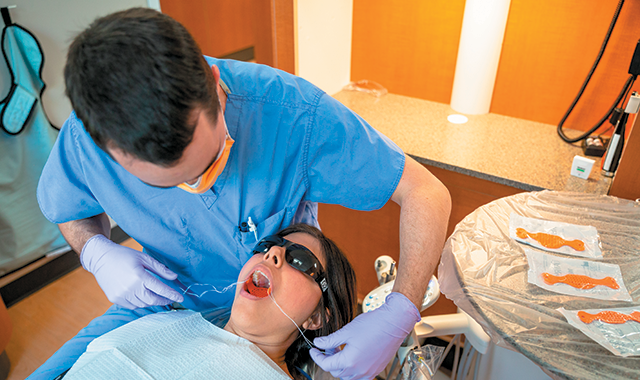Providing patients protection and peace of mind
How Airway Armor creates a barrier to protect a patient’s airway during dental procedures.

During routine dental procedures, patients are inclined back and in a supine position with their open airway left unprotected. If they’re also anesthetized and numb, their gag reflex isn’t very strong. For many years, rubber dams and gauze have been used to attempt to block the aspiration and ingestion of small foreign objects during these procedures.
“There are so many procedures we do such as working with a crown or a small implant where a small object becomes loose and can fall down the patient’s throat,” says Gargi Mukherji, DDS, associate professor and group practice director at the University of Texas Health Science Center at Houston School of Dentistry. “It doesn’t happen often, but when it does happen, it can be life-threatening.”
According to Dr. Mukherji, most dentists don’t use a rubber dam during a crown implementation because it can block accessibility. Gauze may be placed in the back of the mouth, but it can move, get wet, or be suctioned out.
Trending article: Seeing the same dimensions as we operate
“In dentistry, we simply didn’t have a device to protect the back of the patient’s throat,” she says.
Determined to address this ongoing need, Dr. Mukherji, along with her colleague Ralph Cooley, DDS, assistant dean of admissions and student services and associate professor at the University of Texas Health Science Center at Houston School of Dentistry, developed Airway Armor®.
Airway Armor is a perforated, latex-free safety device that provides a protective barrier to prevent dental patients from aspirating or ingesting foreign objects. Durable, stable and comfortable, Airway Armor is designed to be easy to place and simple to remove by looping dental floss through either end. It also provides the clinician with full accessibility.
“The genesis of the idea came from Dr. Mukherji when she was waiting in the hospital during her father’s knee replacement surgery,” Dr. Cooley explains. “She knew there was a need for a device to keep small objects from falling down a patient’s throat, and she sketched a rough draft, which she then shared with me.”

Airway Armor can be used for a wide range of dental procedures, including extractions, restorations, orthodontics, crowns and bridges, and other implant procedures. Available in three sizes, it’s suitable for use with both children and adults.
“Airway Armor is designed to fit against the roof of the mouth or a little farther back toward the soft palate,” Dr. Cooley says. “It is adjustable and can be trimmed to create a unique, customized fit. It also has forgiveness, so it doesn’t cause damage to the soft tissue.”
The added protection of Airway Armor allows dentists to focus on the procedure and creates peace of mind for their patients.
“Some dentists have also told us the patient can rest lightly on the wings to help hold it in place, which allows for a relaxed open position and helps the patient keep their mouth open more comfortably,” Dr. Mukherji says. “The perforations in the device also make it easier for the patient to breath.”
Read more: Managing the fear factor
Drs. Mukherji and Cooley are currently researching the use of Airway Armor in orthodontics and in other medical specialties that perform procedures in the oral cavity.
“We are currently working with our oral surgery department to determine the use of Airway Armor with patients who are sedated and whose gag reflex and ability to cooperate is not always present,” Dr. Cooley says. “It may also be useful to ENTs, for example, who perform procedures such as parotid gland surgery where the back of the throat needs to be protected.”
“We developed Airway Armor specifically to prevent aspiration and ingestion of foreign objects during dental procedures, but our main goal has always been patient protection,” Dr. Mukherji adds. “We, as dentists, must do all we can to protect our patients and provide them and our clinicians with peace of mind.”
